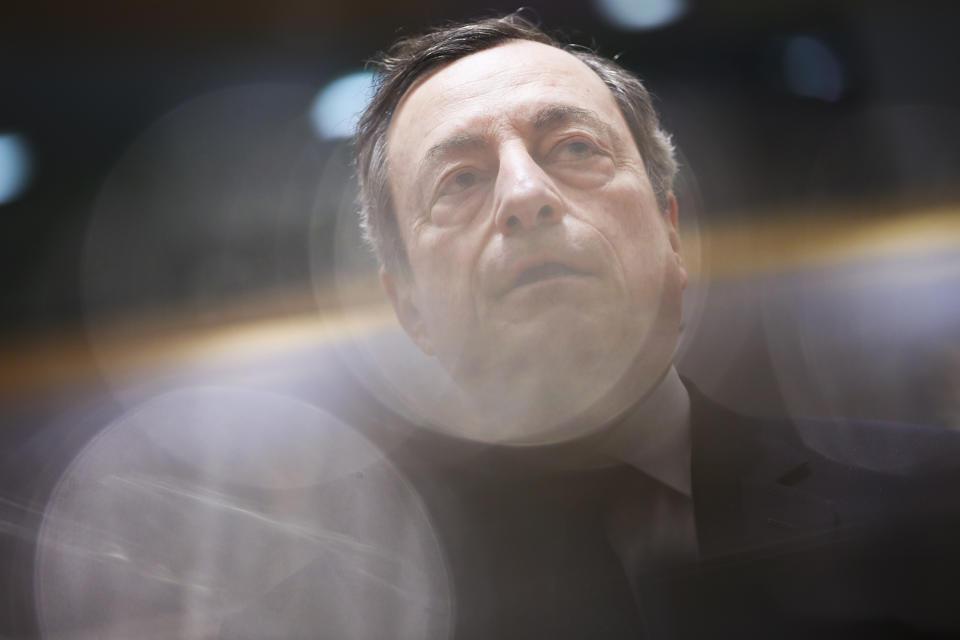Here's why almost nobody likes the ECB's 'roach motel' cheap money policy for banks

The European Central Bank on Thursday took a knife to euro zone growth forecasts and extended a fresh lifeline of cheap lending to banks, unnerving investors and underscoring the diminishing returns of easy money.
The policy decision — coming only months after the ECB curtailed its crisis-era policy of stimulative bond buying — roiled markets rather than reassuring them. In midday trading on Thursday, the Dow Jones Industrial Average (^DJI) tumbled by more than 200 points, while the euro (EURUSD=X) changed hands at around $1.12, down more than half a percent on the day.
“The ECB was more dovish than expected, [and the] euro is paying the price,” said Marc Chandler, chief market strategist at Bannockburn Global Forex. Citing the $1.12-1.1250 area as important in the near term, Chandler added that investors were pricing in an interest rate hike for next year at the earliest.
Ordinarily, accommodative central bank policies send asset prices higher, and cheer market participants. Yet the ECB’s policy reversal reinforced how Europe’s economy remains stagnant — even as the U.S. continues to grow — against a backdrop of a moribund banking sector.
The ECB’s downward revision to growth expectations was “significant...and I fear, one that may still be subject to downside,” Mohamed el-Erian, the chief economic advisor to Allianz and a veteran economy watcher, wrote on Twitter.
On #Eurozone growth, the @ECB reduced its growth forecast for 2019 from 1.7% to 1.1%.
This is a significant revision and, I fear, one that may still be subject to downside (here's why from a Dec @ProSyn column https://t.co/bC8SMX15yL ).
Also raises worries about "stall speed".— Mohamed A. El-Erian (@elerianm) March 7, 2019
‘Roach motel’ policy
Peter Boockvar, chief investment officer at Bleakley Advisory Group, singled out Europe’s negative interest rates, where commercial banks are charged to hold money with the central bank.
In a note to clients on Thursday, Boockvar said the policy was tantamount to a “roach motel” — an allusion to a baited household trap where insects check in, but don’t check out.
“Banks are thus the constituency that suffer the most from this policy at the same time they are the supposed transmission mechanism for it,” the investor said.
“Another way of putting it, the banks are sick dogs and still being asked to run really fast,” Boockvar added, joining other analysts in comparing euro zone banks to Japan.
“Zombification of private business, after taking over Japan, has now infected Europe,” he added.
The ECB’s latest iteration of its Targeted Longer-Term Refinancing Operations (TLTRO), meant to nudge banks to pump credit into the euro zone’s business and consumer sector, is unlikely to have the desired effect, analysts say. The TLTRO’s second round pumped more than 700 billion euros into the 19-nation currency bloc, to little avail for the economy.
More risk taking and less lending
“The ECB's bank lending program is premised on the idea that lending is constricted by available liquidity. It is not,” said Joseph Trevisani, senior analyst at FX Street.
“The problem is demand. The ECB cannot create the economic desire for new business loans,” he added.
In an August 2018 ECB working paper, economists flagged several ways in which negative rates undermine bank lending.
“Banks are reluctant to pass on negative rates to depositors, which increases the funding cost of high-deposit banks, and reduces their net worth relative to low-deposit banks,” the authors wrote.
Accordingly, negative rates can lead to “more more risk taking and less lending by euro-area banks with greater reliance on deposit funding,” they added. “Our results suggest that negative rates are less accommodative, and could pose a risk to financial stability, if lending is done by high-deposit banks.”
In recent years, European banks have scaled back their presence across the continent, according to European Banking Federation data released last year. Although non-performing loans have dropped by 25% over the last few years to around 800 billion, the number of credit institutions have dropped by 31% since 2008, EBF data shows.
—
Javier David is an editor for Yahoo Finance. Follow him on Twitter: @TeflonGeek
Follow Yahoo Finance on Twitter, Facebook, Instagram, Flipboard, LinkedIn, andreddit.
